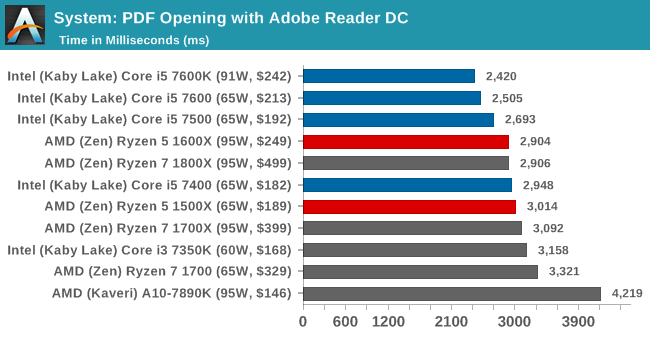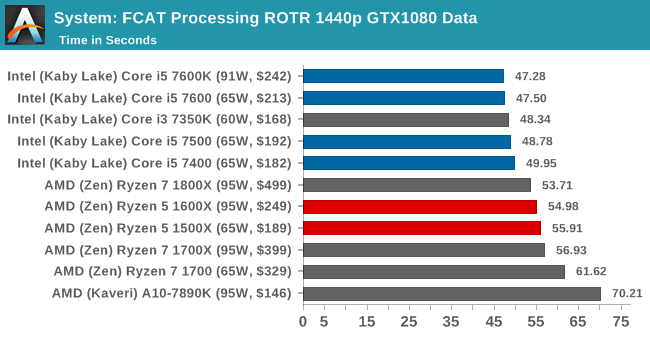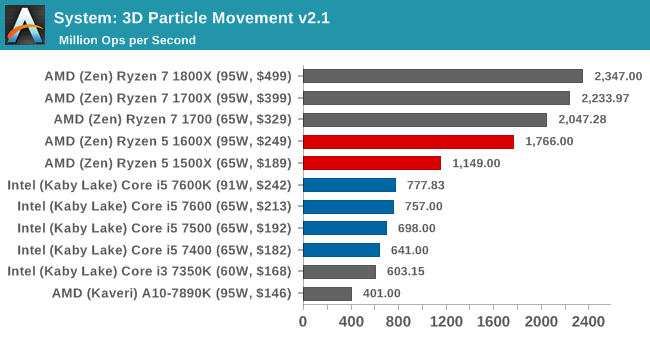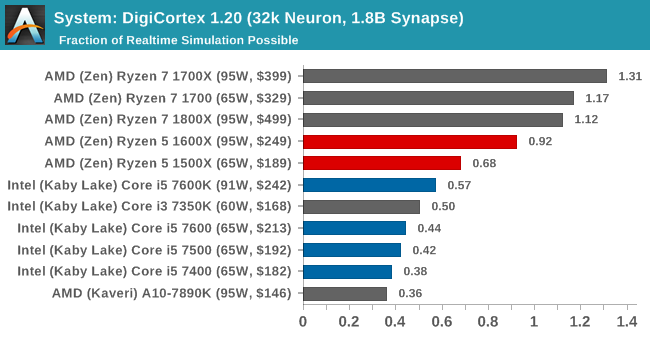The AMD Ryzen 5 1600X vs Core i5 Review: Twelve Threads vs Four at $250
by Ian Cutress on April 11, 2017 9:00 AM ESTBenchmarking Performance: CPU System Tests
Our first set of tests is our general system tests. These set of tests are meant to emulate more about what people usually do on a system, like opening large files or processing small stacks of data. This is a bit different to our office testing, which uses more industry standard benchmarks, and a few of the benchmarks here are relatively new and different.
PDF Opening
First up is a self-penned test using a monstrous PDF we once received in advance of attending an event. While the PDF was only a single page, it had so many high-quality layers embedded it was taking north of 15 seconds to open and to gain control on the mid-range notebook I was using at the time. This put it as a great candidate for our 'let's open an obnoxious PDF' test. Here we use Adobe Reader DC, and disable all the update functionality within. The benchmark sets the screen to 1080p, opens the PDF to in fit-to-screen mode, and measures the time from sending the command to open the PDF until it is fully displayed and the user can take control of the software again. The test is repeated ten times, and the average time taken. Results are in milliseconds.

Opening PDFs using Adobe is significantly single threaded, hence why Intel takes the win here for the most part - the 7400 is slightly lower on frequency, enough for the 4.0 GHz Ryzen parts to push ahead.
FCAT Processing
One of the more interesting workloads that has crossed our desks in recent quarters is FCAT - the tool we use to measure stuttering in gaming due to dropped or runt frames. The FCAT process requires enabling a color-based overlay onto a game, recording the gameplay, and then parsing the video file through the analysis software. The software is mostly single-threaded, however because the video is basically in a raw format, the file size is large and requires moving a lot of data around. For our test, we take a 90-second clip of the Rise of the Tomb Raider benchmark running on a GTX 980 Ti at 1440p, which comes in around 21 GB, and measure the time it takes to process through the visual analysis tool.
Similarly, FCAT is single threaded as it analyzes frame-by-frame. The extra frequency helps Intel here.
3D Particle Movement v2.1
This is the latest version of the self-penned 3DPM benchmark. The goal of 3DPM is to simulate semi-optimized scientific algorithms taken directly from my doctorate thesis. Version 2.1 improves over 2.0 by passing the main particle structs by reference rather than by value, and decreasing the amount of double->float->double recasts the compiler was adding in. It affords a ~25% speed-up over v2.0, which means new data.
DigiCortex 1.20
Despite being a couple of years old, the DigiCortex software is a pet project for the visualization of neuron and synapse activity in the brain. The software comes with a variety of benchmark modes, and we take the small benchmark which runs a 32k neuron/1.8B synapse simulation. The results on the output are given as a fraction of whether the system can simulate in real-time, so anything above a value of one is suitable for real-time work. The benchmark offers a 'no firing synapse' mode, which in essence detects DRAM and bus speed, however we take the firing mode which adds CPU work with every firing.
Agisoft Photoscan 1.0
Photoscan stays in our benchmark suite from the previous version, however now we are running on Windows 10 so features such as Speed Shift on the latest processors come into play. The concept of Photoscan is translating many 2D images into a 3D model - so the more detailed the images, and the more you have, the better the model. The algorithm has four stages, some single threaded and some multi-threaded, along with some cache/memory dependency in there as well. For some of the more variable threaded workload, features such as Speed Shift and XFR will be able to take advantage of CPU stalls or downtime, giving sizeable speedups on newer microarchitectures.

Because parts of Photoscan are very multithreaded, such as the first stage, there's plenty of scope for the Ryzen CPUs to pull ahead here.













254 Comments
View All Comments
marecki - Tuesday, April 11, 2017 - link
PDF OpeningCan you link this PDF file?
Ratman6161 - Tuesday, April 11, 2017 - link
Hmmm. Food for thought. So I've been sticking with my trusty old i72600K. I use VMWAre workstation to run VM's on my desktop quite a lot. I've always figured a lot of threads were helpful so that VM's and the host OS aren't competing for resources. But the VM's themselves aren't doing anything particularly intense. When not running VM's probably any old i5 level of performance is probably good enough. So...for my particular purposes seems like the Ryzen 5 1600X might be the way to go and save a bunch of money while I'm at it???More than adequate for my desktop needs and more cores/threads than an i7 when running VM's...and way cheaper. First CPU I've seen tht's got me kind of tempted.
cheshirster - Tuesday, April 11, 2017 - link
That's where 1700 might look better.IanHagen - Tuesday, April 11, 2017 - link
I too am a heavy virtualization user and I'd say pick the 1700 if you can. More physical and logical cores are going to make a big difference for you.Ratman6161 - Tuesday, April 11, 2017 - link
I'm actually kind of looking for cheap. The Ryzen 5 1600x is more cores and threads than my trusty old i7-2600K and the 1600x is $140 less than the 1700. I'm actually considering going even cheaper and getting the 1600 instead of the 1600x. The main difference between the 1600 and 1600x seems to be clock speed and...they are unlocked so why not save $30 more and get the 1600?Ratman6161 - Tuesday, April 11, 2017 - link
PS: I'm thinking on going cheap with the CPU and using some of the savings on more RAM.psychobriggsy - Wednesday, April 12, 2017 - link
1600 comes with a cooler, 1600X doesn't, so bear that in mind during price comparisons.IanHagen - Tuesday, April 11, 2017 - link
Then I'd say get the 1600 and overclock it (:lakedude - Thursday, April 13, 2017 - link
Ryzen is not offering much in the way of OC headroom. Sure the chips are unlocked but they are already pushing them pretty hard, unlike the Cel300A from back in the day...Ratman6161 - Thursday, April 13, 2017 - link
True, the OC headroom doesn't seem that great. But for anyone willing to do a mild overclock (which I am) it seems like a no-brainer to choose the 1600 over the 1600x. The only difference seems to be clock speed other than the cooler (which I probably wouldn't use) and I'm betting that even pushing it a bit, the two would end up at the same maximum speed.